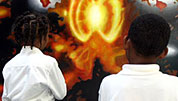
"Can we detect microbial or other non-intelligent life on planets outside of our solar system?"
-
"The State of Astrobiology, 2009" A report from Mary A. Voytek, Senior Scientist for Astrobiology (Interim), NASA Headquarters
March 27, 2009 – The Astrobiology Program is in good health for program year 2009, with a budget of $49.5 million dollars and a full slate of ongoing and new initiatives promising a continuing stream of discoveries. We have two 50th anniversaries to celebrate over the next year: NASA funding of its first exobiology experiment in 1959, and the establishment of the Agency’s Exobiology Program – progenitor of the Astrobiology Program – in 1960. These anniversaries provide good opportunities to reflect on the accomplishments of exobiology and astrobiology at NASA and the future of our rapidly growing field of research.
Fiscal Year 2009 omnibus appropriations legislation allots $17.8 billion to NASA. (The President’s economic stimulus package provides an additional $1.2 billion to NASA, including $400 million for Earth science and $400 million for exploration.) For FY 09, $135 million has been appropriated to NASA for research and analysis programs in the Planetary Science Division. Of that $135 million, the Astrobiology Program is budgeted $49.5 million, an increase of nearly $8 million over 2008 funding of $41.3 million ($34.2 million in 2007).
Funding for the Astrobiology Program in the current program year (2009) now includes $15.5 million for Exobiology and Evolutionary Biology grants (compared to $11.3 million in 2008 and $9.8 million in 2007), $6.5 million for the Astrobiology Science And Technology for Exploring Planets (ASTEP) Program ($5.7 million in 2008, $4.0 million in 2007), $7.5 million for the Astrobiology Science and Technology Instrument Development (ASTID) Program ($8.3 million in 2008, $5.5 million in 2007), and $20 million for the NASA Astrobiology Institute (NAI) ($16 million in 2008, $14.9 million in 2007).
Astrobiology remains a strong cross-cutting theme in NASA space science, knitting together research in astrophysics, earth science, and heliophysics as well as planetary science. “Planetary Science is a grand human enterprise,” NASA says in its FY 09 budget request, “that seeks to discover the nature and origin of the celestial bodies among which we live, and to explore whether life exists beyond Earth. The scientific imperative for Planetary Science, the quest to understand our origins, is universal. How did we get here? Are we alone? What does the future hold?” Astrobiology plays a part in most of NASA’s planetary missions these days and is increasingly a focus of missions to Mars. The Agency’s next flagship mission to Mars, the Mars Science Laboratory (MSL), is NASA’s first astrobiology mission to the Red Planet. Astrobiology will also be a major focus of the European Space Agency’s (ESA’s) upcoming ExoMars mission.
Astrobiology is a major focus of NASA’s plans to explore the outer planets, including Juno mission to the Jupiter system, scheduled to launch in 2011, and the Agency’s next outer planets flagship mission, a Europa/Jupiter system orbiter. Meanwhile, currently operating missions such as NASA’s Mars Exploration Rovers, the Cassini orbiter, the European Space Agency’s Mars Express, the EPOXI and NExT comet exploration missions, and the Dawn asteroid exploration mission are generating data for astrobiology investigations.
Finally, with the study of extrasolar planets commanding more and more attention from astrobiologists, NASA’s Kepler extrasolar-planet-searching mission promises to be a major boon for our field. Kepler is the first extrasolar-planet-detection mission with the ability to find Earth-like planets and is managed by the Astrophysics Division.
2008 progress report
In 2008, NASA’s original 2007 solicitation for Astrobiology Science and Technology Instrument Development (ASTID) proposals was expanded to include concept studies for astrobiology small payloads and satellites (under 50 kilograms mass). In the summer of 2008, the ASTID program approved 15 proposals for funding, including mission concept studies and concept studies for small payloads and satellites. The new projects were selected out of 97 proposals submitted in response to the NASA Science Mission Directorate’s 2007 Research Opportunities in Space and Earth Sciences (ROSES) solicitation. They range from instruments for astrobiology investigations on future planetary exploration missions to a prototype artificial-gravity platform for small satellites and planetary landers to a nanosatellite designed to search for transiting Earth-like extrasolar planets.The ASTID program’s first small-satellite project, O-OREOS (Organism/Organics Exposure to Orbital Stresses), is scheduled to launch as a secondary payload on a Minotaur rocket in February 2010. O/OREOS is intended to demonstrate autonomous, in-situ instrument technology for precise spectroscopic measurements, life support, and biological analysis in astrobiology small payloads. The O/OREOS project is product of the NASA Science Mission Directorate’s (SMD’s) first Stand-Alone Missions of Opportunity Notice (SALMON), issued in 2008, including Program Element Appendix H3: Small Complete Missions of Opportunity in Astrobiology and Fundamental Space Biology. A second SALMON announcement of opportunity (AO) for Astrobiology small payloads is due out this April, with a deadline for proposals this summer and selections planned for 2010.
Also last summer, the Astrobiology Science and Technology for Exploring Planets (ASTEP) program awarded grants to seven new projects, including four field campaigns and three technology development projects. The new ASTEP field campaigns were to take place in terrestrial analogues to other planetary environments, ranging from the high Arctic to Antarctica. The new technology development initiatives are proceeding with an eye toward future missions to Mars, Enceladus, and Europa.
Selection of proposals submitted in response to NASA’s 2008 solicitation for Exobiology and Evolutionary Biology research takes place this spring (stay tuned to this Web site for the announcement of awards). In April 2008, 35 proposals submitted in response to NASA’s 2007 solicitation were selected for “Exo-Evo” funding. These grant awards were for research into the origin and early evolution of life, the potential of life to adapt to different environments, and implications for life elsewhere. A total of 85 Exobiology and Evolutionary Biology grants are currently funded.
In September 2008, the NAI approved five-year grants averaging $7 million each for 10 new research teams, bringing to 14 the total number of teams funded by the Institute.
Closing thoughts
This year marks the 50th anniversary of NASA’s first exobiology investigation: the so-called “Wolf Trap” experiment, funded in 1959 and selected to be flown on the Viking mission to Mars (ultimately, the experiment was not included on the mission). Next year will be the 50th anniversary of NASA’s Exobiology Program, established in 1960 and progenitor (and now an element) of the Astrobiology Program. This year is also, of course, the 200th anniversary of the birth of Charles Darwin and the 150th anniversary of the publication of Darwin’s On the Origin of Species. It seems appropriate to consider the role of Darwin’s work in initiating the study of exo- and astro-biology. At NASA Headquarters, as we think about how to celebrate these anniversaries, we welcome your ideas as well.To wrap up, I want to reiterate that as space exploration missions grow in number, duration, and complexity, astrobiology grows in breadth, depth, and complexity as a scientific focus of these missions. “If we recommit ourselves to discovery,” then-President Elect Barack Obama said on December 20, 2008, “if we support science education to create the next generation of scientists… if we have the vision to believe and invest in things unseen, then we can lead the world into a new future of peace and prosperity.” The Astrobiology Program remains committed to discovery, to training the next generation of astrobiologists, and to investing in things unseen. We look forward to working with you all in fulfilling the President’s wishes.
- Titan First
- Comment on Titan First
- Program Solicitation in Sedimentary Geology and Paleobiology
- NAI Team Seminars Recorded and Available Online
- Outer Space Oreos
- NAI Ames Research Center Team Launches New Website
- Darwin in a Test Tube
- Reflections of Chirality as a Possible Biomarker
- Student Astronomers Earn Top Honors in State Science Fair
- Reanimating Extinct Genes


